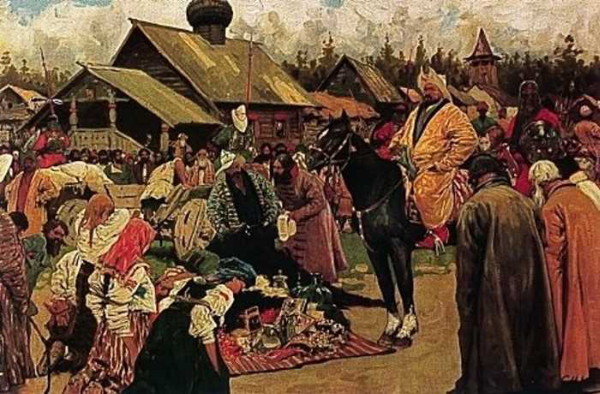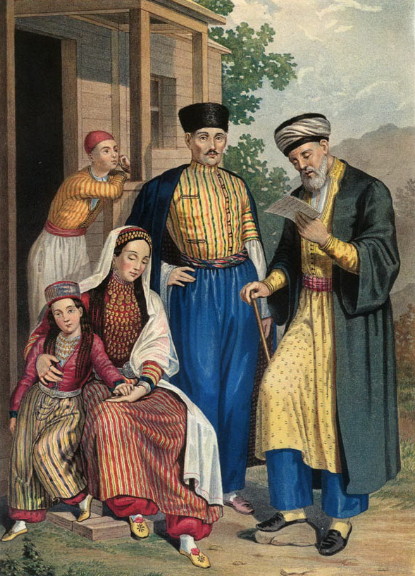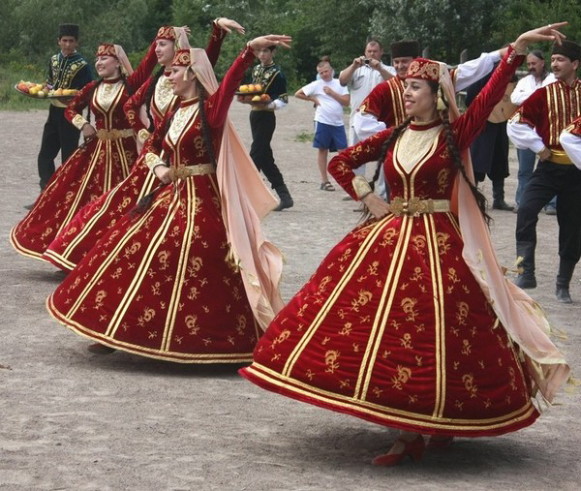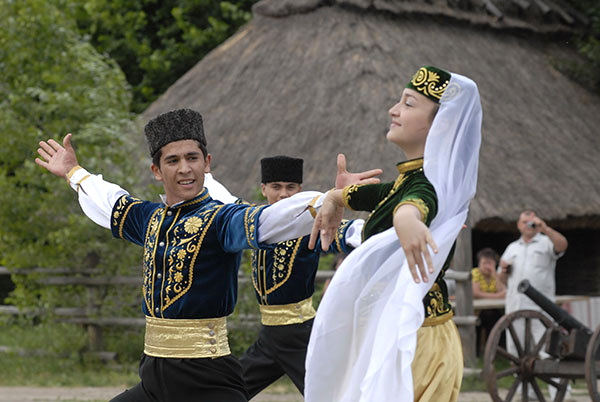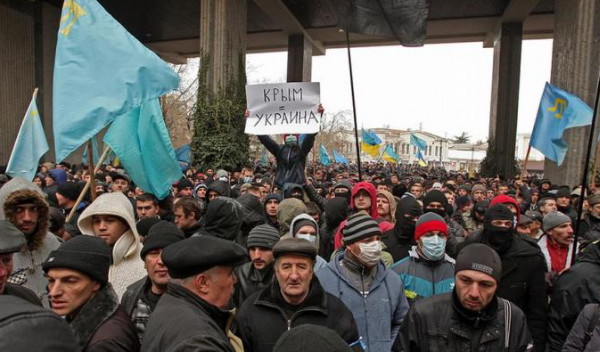Tatars
Tatars [татари; tatary]. The name given to various Turkic and Mongol peoples and tribes of the 13th- to 14th-century Mongol Empire. In 1223 they invaded Kyivan Rus’ under the leadership of Subedei Bahadur and defeated the armies of the southern Rus’ princes (see Mstyslav Mstyslavych and Mstyslav Romanovych) and their Cuman allies at the Kalka River. Having plundered Left-Bank Ukraine they returned to the steppes of Central Asia. After the reign of Genghis Khan the western part of the Mongol Empire was ruled by his grandson, Batu Khan, who expanded his realm into eastern and central Europe in 1236–43. Batu subdued the Volga Bulgars in 1237–8 and then took the northern Rus’ towns of Riazan, Kolomna, Moscow, Vladimir, Rostov, Torzhok, and Kozelsk and slaughtered the northern Rus’ army at the Sit River before turning south and conquering the Cumans along the lower Don River.
Batu Khan then invaded southern Rus’ and sacked Pereiaslav (3 March 1239) and Chernihiv (18 October 1239), thereby laying the path clear to Kyiv. Kyiv's defense was directed, in Prince Danylo Romanovych's name, by the voivode Dmytro. Batu directed the Tatar siege himself. After taking Kyiv he massacred its residents on 6 December 1240 and laid waste the city. His forces then proceeded westward and took Kolodiazhyn (by surprise), Kamianets-Podilskyi, Iziaslav (Zaslav), Volodymyr-Volynskyi, princely Halych, and many other Ukrainian towns. In Volhynia the Tatars split into three armies. One attacked Poland, where on 9 April 1241, near Legnica, it defeated Polish, Czech, and Teutonic Knights; the second invaded Wallachia and Transylvania; and the third and largest army, headed by Batu himself, destroyed princely Halych before crossing the Carpathian Mountains into Hungary. There, on 12 April 1241, it annihilated the Hungarian army at the Sajó River. In the spring of 1242 the Tatars ravaged Serbia, Bulgaria, and the Black Sea littoral before returning to the Volga Basin, the center of Batu's state, known as the Golden Horde.
The Tatars were successful in controlling their large empire because of their administrative method. It included census-taking to determine the amount of tribute; a system of enumerators, scribes, and tax collectors; the division of conquered lands into districts; and the establishment of local administrators to enforce obedience and the payment of tribute. Military service and a type of tax farming were imposed on the people. To maintain full control the Tatars resorted to almost systematic extortion, hostage-taking, and granting of patronage to local princes for faithful service. Periodic bloody raids helped to maintain fear and obedience.
The Tatars were sophisticated warriors. Accustomed to riding and archery from childhood, they were particularly skilled at feigning retreats and luring opponents into ambushes. Such maneuvers brought them victory at the Kalka River, Legnica River, and the Sajó River. Their success in capturing fortified towns was based on their adaptation of Chinese military technology.
The Tatars were shamanists but were tolerant of other religions. In 1261 they allowed an Orthodox bishopric to be established at Sarai, the capital of the Golden Horde, and the Kyivan Rus’ clergy were exempted from paying taxes. Batu Khan's sons and successors, Sartak (1256–7) and Berke (1257–66), were themselves Christian and Muslim respectively. In the early 14th century Khan Uzbek adopted Islam as the official religion of the Golden Horde.
The Tatars were primarily nomadic herders. Merchants were highly valued by the government, and foreign traders received special privileges. The Tatars' Slavic subjects were mostly peasants and artisans. The Golden Horde's principal trading partners were the Italian colonies along the Black Sea littoral and Egypt. Its chief exports were slaves and grain.
The Tatars did not impose uniform demands on all the peoples under their yoke, but modified them according to local conditions. Of all the Ukrainian territories the Principality of Galicia-Volhynia had the shortest and least onerous experience with Tatar suzerainty. After the Tatars returned to the Volga, Prince Danylo Romanovych attempted to organize a European coalition against them and sent Metropolitan Petro Akerovych to the Church Council of Lyons in 1245 to warn of the Tatar menace. When aid from the Catholic West was not forthcoming, Danylo was forced to travel to Sarai, the capital of the Golden Horde, in 1246 to accept the khan's suzerainty. In 1253, however, he recognized the authority of the pope and was crowned a king. He fought the neighboring Bolokhovians and other Tatars’ people who had voluntarily submitted to the Tatars, and in 1252–7 he waged war against Kuremsa, the overlord of the westernmost reaches of the Golden Horde. In 1259 Burundai, Kuremsa's successor, launched a successful campaign against the Principality of Galicia-Volhynia. Even then, however, Galicia-Volhynia did not become entirely subservient to the Tatars until the reign of Lev Danylovych, who was forced to accept the suzerainty of Nogay, the ruler of the Black Sea littoral, in the early 1270s. Living in harmony with the Tatars enabled Lev to annex Polish and Hungarian borderlands, and he participated in Khan Teleboh's campaign against Poland in 1286–7. His son, Yurii Lvovych, and grandsons, Lev Yuriiovych and Andrii Yuriiovych, were actually independent rulers, and the latter two gained recognition in Europe as ‘invincible shields against the Tatars.’ The annexation of Galicia by Poland and of Volhynia by Lithuania spelled the end of the Golden Horde's influence in the western Ukrainian territories.
Other Ukrainian territories were dominated much longer and more harshly by the Golden Horde. Ponyzia, southern Podilia, and southern Pereiaslav principality were under its direct control, and Kyiv principality and Chernihiv principality were administered by vassals from among the Riurykide dynasty. The long duration of the Tatar yoke was catastrophic for the Ukrainian territories. They lost political independence, priceless manuscripts and art treasures perished during the sacking of cities, the decimated population was impoverished by heavy taxation, and cultural stagnation ensued. Tribute, which had earlier been used by Kyivan Rus’ princes for internal development, was now taken out of Ukraine for the enrichment of the Golden Horde.
The Lithuanian grand duke Algirdas was the first to wrest Ukrainian lands from the Golden Horde, by taking advantage of the chaos that prevailed within it in 1360–80. In 1363 he routed a Tatar army in Podilia near Syni Vody, deposed the Tatar vassal Prince Fedir in Kyiv, and replaced him with his own son, Volodymyr (see Volodymyr, son of Algirdas). He also occupied the lands of Chernihiv and Novhorod-Siverskyi. Algirdas's successor, Vytautas the Great, resolved to make the Golden Horde his dependent. He assisted Khan Tokhtamysh in the khan's struggle for control of the Golden Horde. In return Vytautas received the Tatar title to all of Ukraine. Vytautas's military campaign in support of Tokhtamysh ended in the defeat of his Lithuanian-Ruthenian army at the Vorskla River in 1399. He managed, however, to extend his borders to the Vorskla River and the lower Dnipro River, thereby incorporating most of Ukraine in the Grand Duchy of Lithuania.
In the early 15th century the Golden Horde weakened and then disintegrated, and independent khanates, such as the Crimean Khanate, the Kazan Khanate, and the Astrakhan Khanate, emerged on its peripheries. The Great Horde (the nucleus of the former Golden Horde) proved to be the most detrimental to Ukraine: it repeatedly invaded the Kyiv region, Podilia, Volhynia, and even Galicia, in 1444, 1447, 1450, and 1457. In 1482 it sacked Kyiv. The eventual fall of the Great Horde came after the death of its last leader, Khan Shah-Ahmet, in 1505.
In the mid-16th century the Nogay Tatars penetrated into Ukraine from the Volga, Ural, and Caspian steppes and established there the Bilhorod Horde, Yedisan Horde, Yedichkul Horde, and Dzhambulak Horde as vassals of the Crimean Khanate and Ottoman Turkey. In the 1770s the lands of the Nogay Tatars were annexed by the Russian Empire, and the hordes were resettled in the Kuban. In 1790 they were allowed to return to the Sea of Azov littoral, and after the Crimean War of 1853–6 they emigrated to Turkey.
The Crimean Khanate existed as an independent state from 1449 to 1478, when it recognized the supremacy of the Ottoman Empire. Ruled by the Girei dynasty, the Crimean Tatars behaved not unlike the Golden Horde and Great Horde toward Ukraine. By 1556 they had mounted more than 80 invasions of Podilia, Volhynia, Galicia, and the Kyiv and Novhorod-Siverskyi regions, where they destroyed towns and villages and took slaves (more than 35,000 in 1575 alone) to sell at markets in the Crimea. The Ukrainian Cossacks, and after 1648 (see Cossack-Polish War) the Cossack Hetman state, alternated between war and alliance with the khanate. In 1783 the Crimean Khanate with its population of approximately 140,000 was annexed by the Russian Empire. Tsarist national, social, and religious oppression of the Crimean Tatars continued through the 19th century, and thousands of them fled to Turkey. Over 141,000 left after the Crimean War; only 103,000 remained in the Crimea. Colonization of the Crimea by Russians, Ukrainians, Germans, Greeks, and others transformed the Tatars into a minority. A Tatar national revival was initiated in the 1880s by I. Bey Gaspirali, the mayor of Bakhchysarai in 1877–81. It promoted the use of one Turkic language for all Turkic and Tatar peoples in the Russian Empire, educational reforms, modifications in Muslim society, and the emancipation of women. From 1883 to 1914 Gaspirali's journal Tercuman-Perevodchik was published in Bakhchysarai for the Turkic and Tatar intelligentsia in the empire; it propagated pan-Islamic and pan-Turkic ideas. In the early 20th century a nationalist movement of ‘Young Tatars,’ led by A. Mehdi, engaged in revolutionary activity in the Crimea akin to that of the Russian Socialist Revolutionaries. Mehdi and the Young Tatars played an active part in the Russian State Duma of 1907 and co-operated with Ukrainian delegates in the Autonomists' Union. In 1909 N. Çelebi Cihan, C. Seidahmet, and other Crimean students at Istanbul University founded a secret organization for Crimean independence, Vatan (Homeland), which became the basis for the Crimean political rebirth after the February Revolution of 1917.
From 1917 to 1920 the Crimean Tatars struggled for their own independence and took varying stances with regard to the Russian White and Bolshevik regimes and Ukrainian claims to the Crimea. After three years of civil war, terror, and slaughter, in November 1920 Bolshevik forces captured the Crimea, and on 18 October 1921 the Crimean ASSR was established as part of the Russian Soviet Federated Socialist Republic.
Under Soviet rule the Crimean Tatars continued to suffer national discrimination. In 1928, after a brief period of national-communist ‘Tatarization’ the chairman of the Crimean Central Executive Committee, V. Ibrahimov, and 3,500 of his Communist Party supporters were purged as bourgeois nationalists. Some were executed, and many were imprisoned in Soviet concentration camps. In 1928–9, 35,000 to 40,000 Crimean Tatar kulaks were arrested and deported to Siberia and Soviet Central Asia. As in Ukraine, Tatar peasants opposed collectivization, and many of them perished in the Famine-Genocide of 1932–3. In 1936 a campaign to Russify the remaining Crimean Tatars was begun in tandem with further terror, arrests, and purges. The number of periodicals in Tatar was reduced from 23 in 1935 to 9 in 1938. In 1938 the Latin alphabet, which had been used instead of the Arabic alphabet in Tatar education and publications since 1929, was replaced by the Russian Cyrillic alphabet, and many Arabic, Persian, and Turkish words were excised from the language and replaced by Russian words.
Between 1917 and 1933 approximately 150,000 Crimean Tatars—half of their population—had been killed, imprisoned, deported to Soviet Asia, or forced to emigrate. Those who had emigrated to Turkey (eg, E. Kirimal) and Romania remained politically and culturally active. The Tatar émigré cause was supported by the interwar Polish government through the state-funded Oriental Institute in Warsaw. Tatar émigrés collaborated with their Ukrainian counterparts in the Promethean movement in Warsaw and Paris.
During the Second World War, from 1941 to 1944, the Crimea was occupied by the German army and ruled by a Nazi military government. Because some Crimean Tatars had fought against the Soviet partisans in the Crimea, the Soviet government accused the Tatars collectively of collaboration with the Germans, and in 1944 they were brutally deported to Siberia, Kazakhstan, and Uzbekistan. The largest Tatar center became Tashkent. Although a Soviet decree of 5 September 1967 absolved the Tatar nation of collective collaboration, they were not permitted to return to the Crimea until the late 1980s. Ukrainian dissidents spoke out in support of the Tatar community's campaign for the right to return there (eg, Petro Grigorenko (Hryhorenko), Sviatoslav Karavansky, and Viacheslav Chornovil).
The movement to return to the Crimea attracted international attention in the mid-1980s and resulted in the creation of the Soviet State Commission for the Review of the National Demands of the Crimean Tatars in 1987, headed by President Andrei Gromyko. The commission, however, rejected the Tatars' demands for the right to return and for the re-establishment of the Crimean ASSR. The Ukrainian Helsinki Group spoke out in defense of the Tatars, and in its Fundamental Principles of 7 July 1988 it demanded ‘the immediate restoration of the Crimean Autonomous SSR as a part of the Ukrainian SSR, and an organized resettlement of the autonomous republic's population repressed by Joseph Stalin to places of their former residence.’
Ukrainian–Crimean Tatar relations have been studied by Ukrainian historians, such as Mykola Kostomarov, Mykhailo Hrushevsky, Teoktyst Sushytsky, Oleksander Ohloblyn, Dmytro Doroshenko, Domet Olianchyn, Vasyl Dubrovsky, Mykola Tyshchenko, Orest Subtelny, and Victor Ostapchuk. Tatar motifs have appeared in the works of Ukrainian writers, including those of M. Kostomarov, Stepan Rudansky, Mykhailo Kotsiubynsky, and Lesia Ukrainka. Ahatanhel Krymsky wrote surveys of Crimean Tatar history and literature, and materials about the Crimean Tatars were published in the journal Skhidnii svit (1927–31).
After the Second World War Soviet scholars paid attention only to the Tatar ASSR (Tataria), that is, to the Tatars of the Volga Basin and the Urals, descended from the Volga Bulgars, the Golden Horde, and the Kazan Khanate.
According to the 1989 Soviet census there were 271,715 Crimean Tatars in the Union of Soviet Socialist Republics, of whom 251,537 stated that Tatar was their native language. Of the total number only 46,807 lived in Ukraine, 43,334 of whom stated that Tatar was their native language. In 1989, 86,875 other (non-Crimean) Tatars also lived in Ukraine; only 42,489 gave Tatar as their native language, and 42,601 gave Russian.
The resettlement of the Crimean Tatars to their ancestral lands in the Crimea developed only after the 1991 Ukraine’s Declaration of Independence. Today some 250,000 Tatars reside in the Autonomous Republic of Crimea.
BIBLIOGRAPHY
Smirnov, V. Krymskoe khanstvo pod verkhovenstvom Ottomanskoi Porty do nachala XVIII veka (Saint Petersburg 1887)
———. Krymskoe khanstvo pod verkhovenstvom Ottomanskoi Porty v XVIII stoletii (Odesa 1889)
Curtin, J. The Mongols: A History (Boston 1908)
Seidamet, D. La Crimée: Passé-présent, revendications des Tatars de Crimée (Lausanne 1921)
Kryms'kyi, A. (ed). Studiï z Krymu (Kyiv 1930)
Doroshenko, D.; Rypka, J. Polsko, Ukraina, Krym a Vysoká Porta v první pol. XVII stol. (Prague 1936)
Nasonov, A. Mongoly i Rus’: Istoriia tatarskoi politiki na Rusi (Moscow and Leningrad 1940)
Kirimal, E. Der nationale Kampf der Krimtürken (Emsdetten 1952)
Zhdan, M. ‘The Dependence of Halych-Volyn' Rus' on the Golden Horde,’ SEER, 25 (1956–7)
Horn, M. Skutki ekonomiczne najazdów tatarskich z lat 1605–1633 na Ruś Czerwoną (Wrocław 1964)
Zhdan, M. ‘Ukraïna pid panuvanniam Zolotoï Ordy,’ UI, 7–8 (1970–1)
Spuler, B. The Mongols in History (New York, Washington, and London 1971)
Grekov, I. Vostochnaia Evropa i upadok Zolotoi Ordy (na rubezhe XIV–XV vv.) (Moscow 1975)
Fisher, A. The Crimean Tatars (Stanford 1978)
Allsen, T. ‘Mongol Census Taking in Rus', 1245–1275,’ Harvard Ukrainian Studies, 5, no. 1 (March 1981)
Egorov, V. Istoricheskaia geografiia Zolotoi Ordy v XIII–XIV vv. (Moscow 1985)
Halperin, C. Russia and the Golden Horde (Bloomington 1985)
Sanin, G. Otnosheniia Rossii i Ukrainy s Krymskim khanstvom v seredine XVII veka (Moscow 1987)
Chambers, J. The Devil’s Horsemen: The Mongol Invasion of Europe, 2nd rev edn (London 1988)
Tyszkiewicz, J. Tatarzy na Litwie i w Polsce: Studia z dziejów XIII–XVIII w. (Warsaw 1989)
Mykhailo Zhdan, Arkadii Zhukovsky
[This article originally appeared in the Encyclopedia of Ukraine, vol. 5 (1993).]
